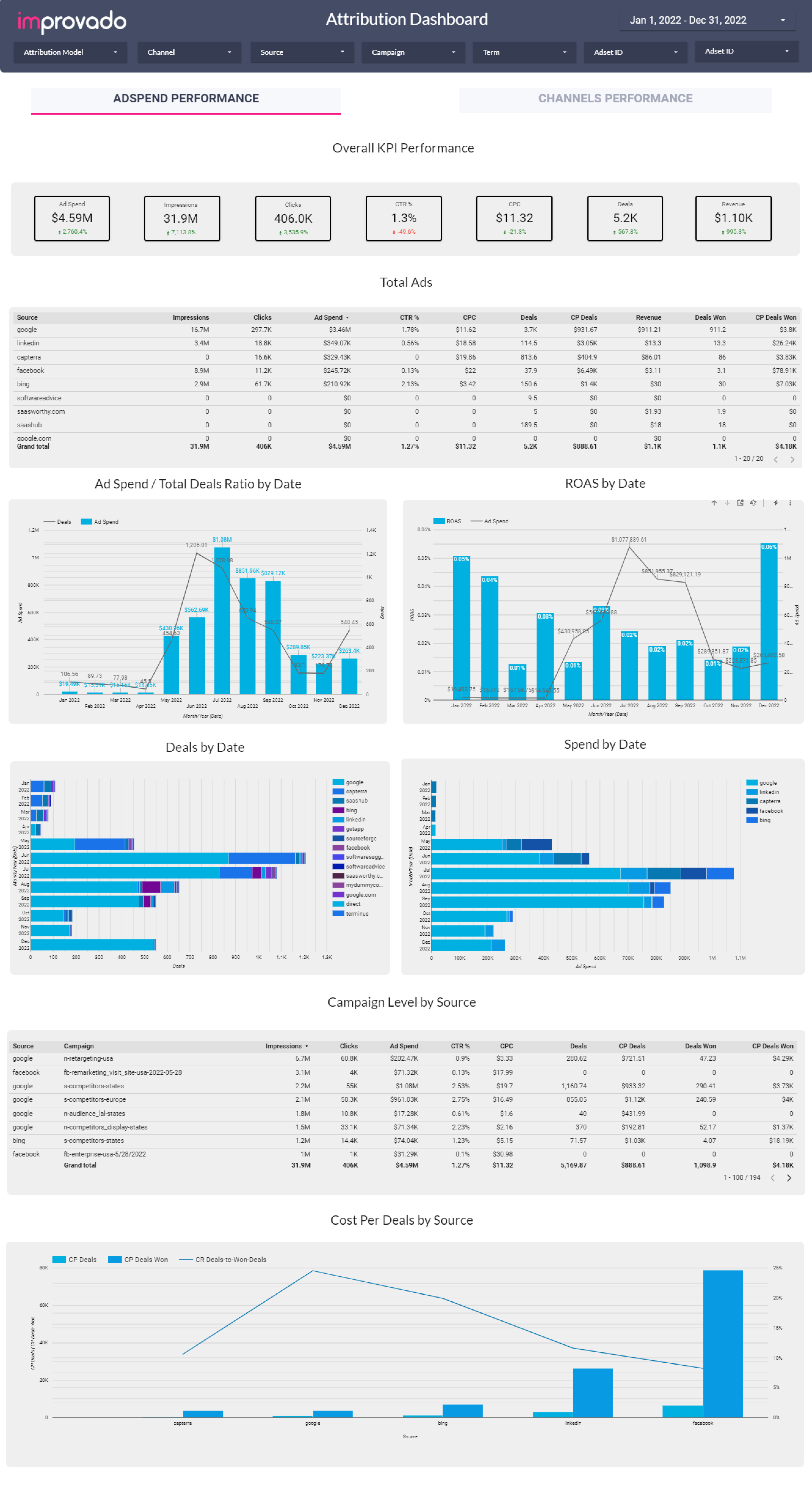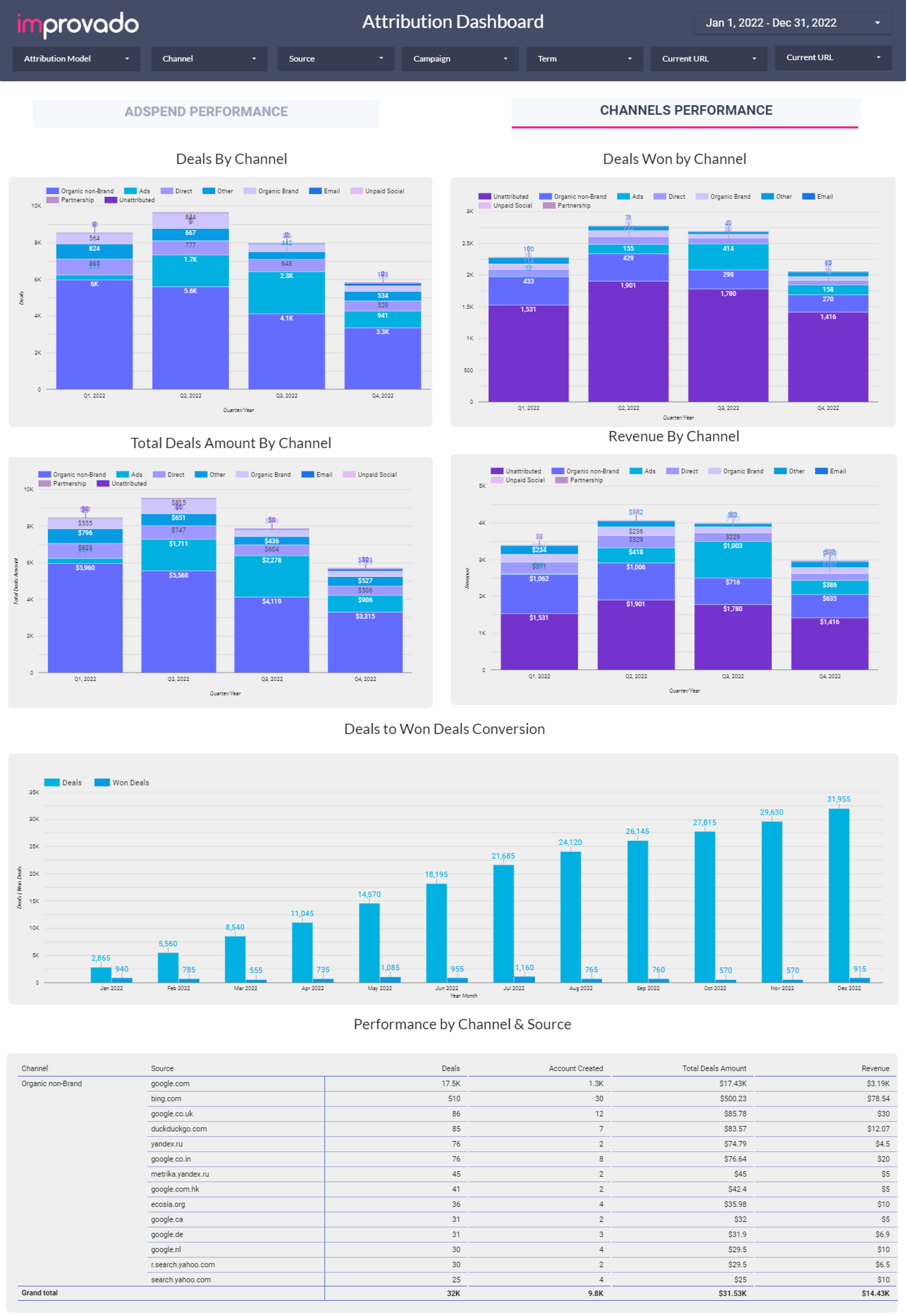In our vast marketing landscape, sales and marketing teams now use more tools and channels than they can count, all designed to transform potential leads into tangible profits.
Jim Lecinski’s research shows that the average customer uses from 5.8 to 18.2 touchpoints (depending on the industry your company operates in) on average to make a purchase decision.
Organizations have to navigate the tangled web of owned, paid, earned, and category media to understand which channels generate revenue and how prospects discover their brand.
The main hitch is that marketers control only around 20% of the channels that users interact with. A marketing website, paid ads, and social media accounts are a drop in the ocean when you’re trying to recreate a complete customer journey. Unfortunately, most marketing teams make decisions based on this incomplete data.
The key to solving this challenge lies in full-funnel attribution. This is the compass to navigate the intricate map of the customer journey.
Tour de headlines:
What is Full-Funnel Attribution? Exploring the concept and significance of full-funnel attribution.
The Challenges of a Full-Funnel Attribution. Unveiling the hurdles in implementing full-funnel attribution.
How to Set Up Full-Funnel Attribution. A step-by-step guide to establishing a full-funnel attribution model.
How to Attribute Revenue from Offline Ads. Expanding the attribution model to incorporate offline advertising.
Automating Marketing Attribution. A deep dive into maximizing marketing ROI without spending months on building a full-funnel attribution.
What is full-funnel attribution?
As a result, marketers can see how each touchpoint influenced the conversion and how each of their channels impacts revenue generation.
In the joint effort of sales and marketing teams, full-funnel attribution serves as your roadmap. It allows you to understand your customers' journeys, optimize your efforts, and direct the flow of your marketing dollars to where it’ll result in the highest ROI.
Why your organization should use full-funnel attribution
If the concept of full-funnel attribution doesn’t seem convincing enough for you, we’ll discuss the particular benefits that full-funnel attribution brings to your business.
An absolute view of your marketing performance
Teams that track performance only across paid and owned media get only a fifth part of insights into channels that generated a conversion. This leads to almost blindfolded budget allocation and inefficient marketing decisions.
Companies that use full-funnel attribution can recreate the entire customer journey, even across earned and category media. With this level of visibility into customer interactions, marketers can clearly see at which stages customers fall out of the funnel, which leads have higher buying intent, and which channels should be prioritized to achieve higher ROI.
Higher customer retention rate
A full-funnel attribution isn’t only about acquiring new customers. It’s also about nurturing existing clients and turning them into product champions that spread the positive message about your solution and will be more likely to bring in more revenue over time.
As well as tracking interactions with prospects, a full-funnel model helps you understand how exclusive branded content, webinars, access to new features, and discounts help you retain customers or increase recurring revenue (in the case of a subscription-based business model).
Finding the channel that fits your goals
The hierarchy-of-effects theory tells us that different marketing activities have a different impact on customer decision stages. Hence, each media area and channels play different roles across funnel stages.
The full-funnel attribution model clearly shows you which activities generate more awareness and which work best to bring in new customers.
For example, research showed that display ads work best for generating awareness, while the direct channel and paid search ads usually close the conversion path.
The challenges of a full-funnel attribution
If you’re wondering why all teams aren’t using the full-funnel approach, there are quite a few reasons.
Isolated data across departments
First things first, your attribution needs data. This data is often scattered across different departments.
For example, ad platforms store data about the cost of advertising and acquiring new leads, while CRM systems used by the sales team store data about leads, opportunities, and deals. The finance department gathers information about generated revenue, revenue generated by each client, upsells, and more.
Without connecting the dots between marketing, sales, and finance data, you can’t recreate the complete buyer cycle and, as a result, can’t identify which marketing activities have the highest ROI.
To harness the power of full-funnel attribution, you need to collect data across departments and feed it to your attribution model. We’ll touch upon breaking data silos and aggregating data further in the article.
Lack of real-time view of your data
Next comes the continual process of supplying your attribution model with fresh data. Even if you have accessible data across the company, you still need to deliver it to the attribution solution.
Doing it manually is a poor option due to the number of routine tasks your team has to perform. Wandering across different platforms, exporting CSV files, handpicking the required data, and copypasting it to a spreadsheet or a database your attribution uses as storage.
It doesn’t sound like a huge problem if you check in with your attribution once a month, but checking it once a month doesn’t make much sense. To keep good track of your cross-channel efforts, you need to check the attribution report daily. And that is almost impossible because gathering and turning raw data into a digestible format can take much longer than a single day.
What you need is automation pulling your data from all sources and feeding it to your attribution model.
The problem of choosing the right model
While full-funnel attribution is a great solution, it’s always backed by different attribution models. The choice of the model strongly depends on your marketing goals, so it’s crucial to choose the right one to get the most accurate credit distribution across channels.
Different models assign credit to customer touchpoints differently, and no one-size-fits-all solution exists. It requires a deep understanding of your customer journey, and that can be complex for a large company.
For example, the first-touch model assigns all credit to the first interaction during the customer journey, while the last-touch model gives all credit to the last one. Below you can find a guide that lists all pros and cons of each model to help you confidently choose the right one for your business.
How to set up full-funnel attribution
As we’ve outlined all pros and cons of full-funnel attribution, it’s time to see how you can get it up and running in your organization.
There are four key steps to create a full-funnel attribution:
- Assign a unique user ID to all website visitors
- Combine all lead data in a single source of truth
- Attribute revenue to each user interaction
- Visualize attribution data using your favorite visualization tool
Assign a unique user ID to all website visitors
First off, you need to identify each individual user that wonders across touchpoints with your brand.
Marketing analytics solutions like Mixpanel or Heap allow you to assign unique user IDs and device IDs, as well as combine this data to identify the same visitor accessing your website from multiple devices.
In case you’re going to combine data from your CRM and Google Analytics, you’ll need to match each visit to a ClientID with Google Analytics API.
Marketing analytics platforms can save you weeks on matching data from CRMs, web analytics platforms, and paid platforms.
Improvado, for example, automatically connects hit-level data from sources such as Salesforce, Mixpanel, Hubspot, Google Analytics, and more. Then, it stitches all the available data about the visitor together (emails, visitor ID, company name, etc.) to create a unique visitor profile and find its interactions across 500+ platforms supported by Improvado.
Unlike other attribution solutions, Improvado doesn’t require any additional tracking pixels. It works seamlessly with Google Analytics, Adobe Analytics, or any other pixel, so you don’t have to worry about the decreased performance of your website.
Combine all lead data in a single source of truth
After capturing all data, you need a place where it will sit conveniently. Storing all data in one place is crucial because your attribution solution needs constant access to it.
In the perfect world, you’d need to set up a marketing data warehouse. It acts as a central hub where you can consolidate all of your marketing data. CRM data, web analytics, paid ads performance - everything is collected and stored in one place.
What’s more, it stores your historical data, ensuring that you can see how revenue was distributed across channels a week, month, or year ago. This allows you to compare your current performance to historical and identify trends, seasonality, and more.
If you don’t want to get bogged down in data engineering, Improvado provides managed data warehouse services. We set up and maintain a Google BigQuery storage for all your marketing data.
The main advantage of a managed data warehouse is that Improvado grants you full access to your data. Even if you part ways with Improvado, you won't lose it. This is a guarantee other vendors do not offer.
Attribute revenue to each user interaction
Finally, the most important part of the process.
When the deal passes into the closed/won stage, it’s time to attribute the generated revenue to touchpoints.
Here’s how it works.
Imagine you run three campaigns on Instagram Ads, and it’s to take a look at the metrics.
While looking at these raw numbers, you’re probably thinking that the first campaign is the most effective considering the highest CTR and low CPC.
However, everything changes when attribution shows you the revenue generated by each campaign.
Here’s the updated view of the previous table:
As you can see, even though the third campaign generated the smallest number of clicks, it brought the most revenue to the company with a low cost per click.
With only this information, we can clearly see that users targeted by this campaign either have a higher buying intent or a higher average contract value.
Visualize attribution data using your visualization tool
To turn your attribution data into a digestible form and share the insights with all stakeholders on your team, you need to build a dashboard that shows how revenue is distributed across all channels.
There are numerous tools that will help you accomplish this goal. Tableau, Looker, and Power BI are some of the most prominent examples.
Attribution dashboards may vary from simply showing revenue attributed to your channels or campaigns to showing a breakdown by each metric across every platform using historical data.
The more granular your dashboard is, the more trends you can see, understand how prospects travel across the funnel, which of your efforts bring more leads or revenue, and how you can optimize budget allocation to maximize profits.
Improvado also handles this task.
We send attribution data to our pre-built dashboard templates in 10+ visualization tools. Instead of building the dashboard from scratch, you take the fast lane and jump straight into the analysis.
Here’s, for example, an attribution dashboard that helps you track the effectiveness of your paid channels:

It shows you how your campaigns perform and how effective each advertising platform is in terms of revenue generation.
Also, you can keep track of vital metrics such as ROAS, which is a measure of revenue earned for each dollar spent on marketing campaigns. Ad platforms rarely provide ROAS, so Improvado calculates it separately (as well as a bunch of other metrics).
Next, we have a channel performance attribution dashboard:

It attributes revenue to each of your marketing channels, helping you allocate budgets more efficiently.
With Improvado, you can play with different attribution models by simply checking the applied model in the upper left corner of Improvado’s dashboard. This allows you to quickly find the model that suits your objectives best.
Beyond full-funnel: how to attribute revenue from offline ads
A full-funnel attribution model stops being “full” if you run ads across offline mediums such as TV ads or out-of-home ads.
Attribution models use click path data to measure channel performance, so it’s not so easy to incorporate offline ads into your attribution infrastructure.
However, there are several workarounds that you can use.
The first one is to run a test, serving ads to test and control groups across similar geographics to measure the performance of your offline campaigns. Then you test results as a constant value in your report.
Alternatively, you can use before-after tests to compare performance for two different periods of time.
Without regard to the test you choose, you have to keep in mind the seasonality and minimal recommended test duration. Ideally, you have to run the test for at least four weeks to get trustworthy results. Also, don’t run your tests in periods of fluctuating conversion rates, such as Black Friday or major holidays.
Increase marketing ROI by over 400% with automated marketing attribution
Implementing attribution is a crucial but very labor-intensive task. It requires significant financial investment, engineering expertise, and absolute commitment from the marketing team. And, like many other large projects, DIY attribution needs to be continuously maintained because different platforms’ APIs constantly change and evolve.
Large companies with complicated data infrastructure often implement full-scale marketing analytics platforms with attribution features. It offers a set-and-forget experience with fresh customer journey insights.
Improvado’s marketing attribution solution provides tech and support that large enterprises need to build and automate full-funnel attribution. The platform pulls data from 500 data sources, including Google Analytics, Mixpanel, Adobe Analytics, Google’s ad platforms, Instagram, and more, enabling companies with a comprehensive picture of revenue-generating touchpoints.
Improvado also supports B2B features allowing you to map all user interactions down to an account level. In this way, marketing teams get a full overview of the complex B2B customer journey.
.png)



.png)
